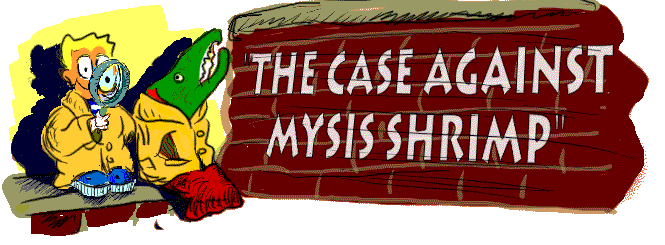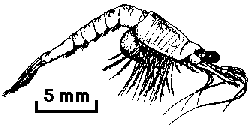A Kokanee Kid’s Mystery


Even when all the creatures in a particular ecosystem that scientists are interested in can be seen with the naked eye, scientists cannot figure everything out just by looking. For example, even if they observe that lots of Mysis shrimp (shown above) feed on young Kokanee fry, that isn’t a good enough reason, by itself, to say that the Mysis shrimp are to blame for the decline of Kokanee. Scientists can’t be everywhere at once. How do they know it’s not really something else?
Rather, a case must be made before laying blame on the Mysis shrimp. Scientists sometimes call this finding the convergence of evidence. When things “converge” it means that they all arrive at the same point. When evidence, or “proof”, converges, it means that a number of different occurences seem to suggest the same thing.
A case against Mysis shrimp is made below. Notice that the evidence the scientists have found does several things:
- It eliminates some other causes of what could be causing the decline of the Kokanee, like Kokanee fishing.
- It finds situations that are “in common”, e.g. the shore-spawning Kokanee are in the lake, the stream-spawning Kokanee are also in the lake, and so are the Mysis shrimp.
- It enables them to ask questions such as, “If this is happening, then why isn’t that happening?” In number 4 in “The Case against Mysis shrimp”, scientists ask the question “If there are fewer Kokanee in the lake, then why aren’t they getting any bigger? There should be more food to divide between them.”
- QUESTIONS FOR KOKANEE KIDS:What other things could the scientists try to discover in order to prove that Mysis are the main thing responsible for missing Kokanee?
What kind of answers would they get if they were right?
What kind of answers would they get if it were something else causing the missing Kokanee?
“The Case Against Mysis Shrimp”
- The Mysis are implicated in other Kokanee crashes.
- Fishing for Kokanee is no longer a major force in affecting numbers; the 1994 catch was fewer than 21,000 Kokanee.
- Both shore- and stream-spawning Kokanee have declined dramatically. This suggests there is a common culprit in the lake.
- Reduced population numbers have not resulted in larger size Kokanee. Is something else taking the Kokanee’s food?
- In 1993, only 1.2% of eggs became fry (in most other areas, it’s 5%). Again, this suggests a culprit in the lake.
- Biomass of Mysis in 1993 was equivalent to 2.6 to 4.3 MILLION Kokanee.
- Recent modelling work using Okanagan Lake information suggests that mysids consume SIX TIMES the zooplankton that Kokanee do.






